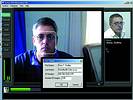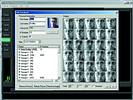

Innovative uses of face recognition, not surprisingly outside the security industry, are becoming more commonplace as the convergence of security with IT continues. From marketing to birth control, including finding lost children and CRM, facial biometrics is the tool in the IT world by which never-before-achieved interaction is occurring, especially as ROI becomes the guiding criteria.
In the rapidly changing digital world it is important to understand that information and the rapid and efficient interpretation of this information is the key to effective decision-making. I-Cube `Integrated Intelligent Imaging', with open-architecture systems, hardware and software, provides the artificial intelligence on a digital platform to turn routine events into valid customer interactions. In essence these systems automate entry, process and inspections within an operation, reducing manpower and the inherent human failure, allowing brands to inspire and improve.
New realtime biometric alternatives in marketing are a reality with the Acsys lightning fast Face Recognition System. Biometric technology, and specifically face recognition, which can recognise people from a facial image, is becoming cheaper and more powerful as technology improves. For the most part, biometrics appears to be a technology whose time has come from the marketing viewpoint. In all these examples, biometrics is being used as a tool by which to confirm identity, not as the primary identification. Biometric applications should be seen as an extension of human intelligence, and not as a replacement for it, because automated identification will only be as good as the human intelligence that backs it up. The danger of not relying on technology to assist is nowhere more real than in the area of marketing. The use of the technology is most effective if the people you are trying to locate are aware of its use and use it regularly. Audit trails left by an individual as he or she uses casinos, gyms, car rentals and any other services that require biometric authentication could become a significant contribution to marketing systems which can create 'loyalty beyond reason'.

Marketing
The marketing department may want to use biometric face recognition solutions to enhance the brand building experience to the benefit of the brand. In today's market environment, customers expect the brand to nurture the relationship, with multiple points of contact with the consumer. This would build consumer confidence; loyalty and satisfaction, lower marketing costs, increase margins, and provide an opportunity for brand extension (Love Mark concept - the future beyond brands by Kevin Roberts). Acsys face recognition techniques have the ability to increase the loyalty of the users, which could be the spark that could propel marketing, to become a greater strategic ingredient.
Rather than reacting to outside forces, the marketing department could lead the way in solving the problems. All companies engage in a constant battle to use technology to enhance their competitive position. In order to overcome the problems associated with being at this technological edge, the understanding, then selection of appropriate technology, is crucial.
In the security world nothing less than 100% is acceptable, while in marketing, percentages of 0,4% return could be exceptional and give valid indications of customer satisfaction. Being able to dramatically increase both customer participation and quickly obtain measurements makes face recognition an excellent tool in marketing. For example, a large casino in South Africa can improve the speed of enrollment (from 3 minutes to under 10 seconds), enjoyment by the client (as the system provides feedback by talking) and accuracy of images (so the images can be used elsewhere in the customer brand building process) obtained when issuing the casino loyalty cards. Immediately the number of loyalty card members would increase, a positive spin off. The marketing department could then ensure that repeat visitors are correctly addressed, and possibly their favourite drinks be ready before they approach reception. This is achieved by the use of the HNet neural network of the Acsys face recognition system, which continually and importantly automatically (without user intervention) updates the person images so the record remains usable.
The application of biometric face recognition techniques as proposed will lead to an increase of core competence. The marketing department needs to grow with the availability of techniques to monitor customers, this is a subsystem and the combination of skills, processes, technologies and assets which come together within each subsystem to confer sustainable, repeatable and unique competitive advantage. It is essential to plan and execute new categories, which continue to build and reinforce these competences.

Better service levels via face recognition
Consumers are time limited, and multiple examples exist where people will pay a premium for quicker, safer or more convenient access. Who would not be prepared to look at a camera so that you could gain entry quicker, allowing the brand to reach more people while giving the brand the ability to respond? There is greater focus on the social responsibility of brands, where taking care of the consumer (for example problem gamblers) becomes crucial.
It is now possible to follow a person through their life via face recognition, from minutes after birth (where face recognition is used to ensure that no accidental switching of babies occurs at the hospital), identifying lost children (via a picture of the lost child submitted via your cellphone), confirming the identity of the person collecting important documents or cards and confirming the identity of pensioners via face recognition.
The above can occur by the use of the Acsys biometric solutions, which offer speed, accuracy and intelligence. Using a revolutionary core technology called HNet, Acsys Biometrics delivers cutting-edge security with basic hardware requirements and split-second processing times. The Acsys FRS (face recognition system) was the most accurate technology tested in the International Biometric Group's Comparative Testing for IT Security and E-Commerce (0% false acceptance rate (caught all impostors) at an excellent false rejection rate of just 3,1%. The system learns, remembers and recognises. HNet emulates the human brain in structure and function, becoming more familiar with your face each time it sees you, adjusting for difference due to aging and cosmetics without increasing the size of the biometric template.

Biomimetic intelligence
Biomimetic intelligence is the science of understanding and replicating the processing mechanisms and structure of the brain. Traditional neural networks have little or no resemblance to actual neurological structures and, more importantly, have proven to be very limited in capability. The HNeT technology, however, applies the power of digital holography within synthetic neuron cells. Assemblies comprised of such cells have one-to-one correspondence with the primary cell structures of the brain. These biomimetic structures provide the capability for truly realtime learning and present a vast increase in (stimulus-response) memory storage capacity. Biomimetic intelligence models cell inter-connectivity and signal processing aspects of actual neuron cell assemblies within sections of the brain referred to as the neo-cortex (grey matter or outer layer), the cerebellum (near the base of the brain) and the hippocampus.
The mathematical basis for HNeT permits vast numbers of stimulus-response patternto be learned and superimposed (enfolded) onto a matrix comprised of complex scalars, called the cell's cortical memory. In fact, the number of values used to store cortical memory is often no larger than the number of values contained within a single stimulus pattern. The mechanism for holographic storage displays a capacity to achieve extremely high information densities, due to the fact that large numbers of stimulus-response memories can be enfolded onto the same set of scalars (in other words - computer RAM).
For more information contact Barry T. Dudley, I-Cube, 082 562 8225, [email protected]

© Technews Publishing (Pty) Ltd. | All Rights Reserved.